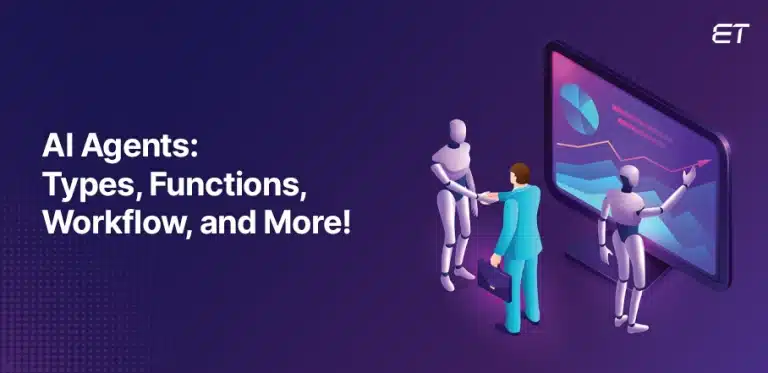
AI Agents: A Complete Guide to Types, Uses, and Benefits
- AI agents are computer programs that act independently of their surroundings or environment
- An AI agent can automate tasks, interact, and make helpful decisions
- Robotics, chatbots, and smart home devices are common applications of AI agents
- Machine learning, data, and natural language processing are the key technologies that enable these agents to work independently
Did you watch the movie Wall-E? It’s a captivating tale of a lonely robot in outer space. Now, remove the emotional aspect from that movie (because AI or robots don’t feel emotions in the real world). After doing so, you can envisage the concept of AI agents.
An AI agent is, in simple words, ‘automation with intelligence.’ These are hi-tech computer programs that use artificial intelligence to make informed decisions. Chatbots, smart robots, and modern devices are all good examples of such agents.
As a professional or a decision maker, it helps to understand hi-tech technologies like these. With such knowledge, you can always implement cutting-edge solutions at your workplace.
So, this blog will inform you about AI agents and their types. There’s much more to unravel, so scroll ahead, and we’re sure you’ll find this piece interesting!
What are AI Agents?

Imagine a remote-controlled car that’s driving itself. Yeah, it’s pretty similar to an autonomous vehicle.
What if this car has sensors and a brain that helps it decide the best path?
Such a car can make a new movie plot! Okay, coming back to reality. Here’re two main points about this automobile:
- The brain has special programming to follow a path or avoid obstacles
- The more the car drives around, the better it gets at following its path or avoiding bumps
AI agents are like this self-driving remote-controlled car. Instead of wheels, an AI agent might use the following:
- Screens
- Keyboards
- Cameras
- Microphones
They all work the same way – sense things, think about what they sense, and take action to reach a goal. Just like the remote-controlled car is getting better at driving, AI agents can learn and improve over time. Quite fascinating, right?
How Does an AI Agent Work?

In AI, an agent is a system adhering to the PEAS model. Here’s what the model is all about:
- Performance measure: A metric evaluating the AI agent’s success in achieving goals
- Environment: The world the agent interacts with, perceived through sensors
- Actuators: Mechanisms the agent uses to affect the environment
- Sensors: Methods for gathering information about the environment
AI agents leverage techniques like machine learning, NLP, reasoning, and knowledge representation to perceive, decide, and act upon their environment to achieve specific goals.
Now, with that information, let’s move on to understand the different AI agent categories.

Interested in AI? Then, explore our AI software development services today!
The Types of AI Agents
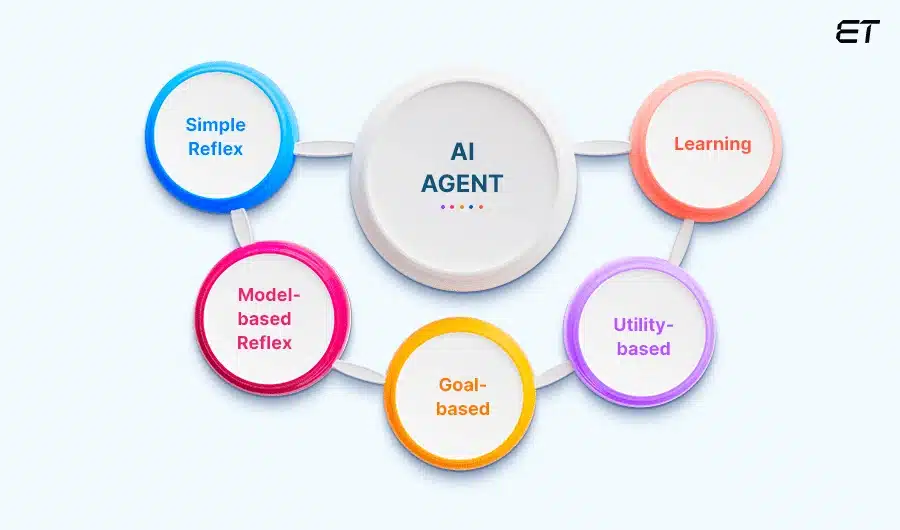
Tasks and environments define the type of AI agent to use. We’ll explain each type in details. However, here’s a quick glimpse of the main categories:
| Type of AI Agent | Quick Explanation |
| Simple Reflex | These agents react immediately to their surroundings based on pre-defined rules |
| Model-based Reflex | They are similar to simple reflex agents but maintain an internal model of their environment. This model allows them to handle situations where not everything is directly observable |
| Goal-based | These agents have specific goals in mind and plan their actions accordingly |
| Utility-based | These AI agents go beyond goals and consider the desirability of different outcomes |
| Learning | These agents can enhance their performance over time by learning from experience |
There are other types of AI agents like hierarchical, and multi-agent systems. However, the above five categories are the core segments of this technology. Now, let’s move on to understand each AI agent type deeply.
Simple Reflex Agents
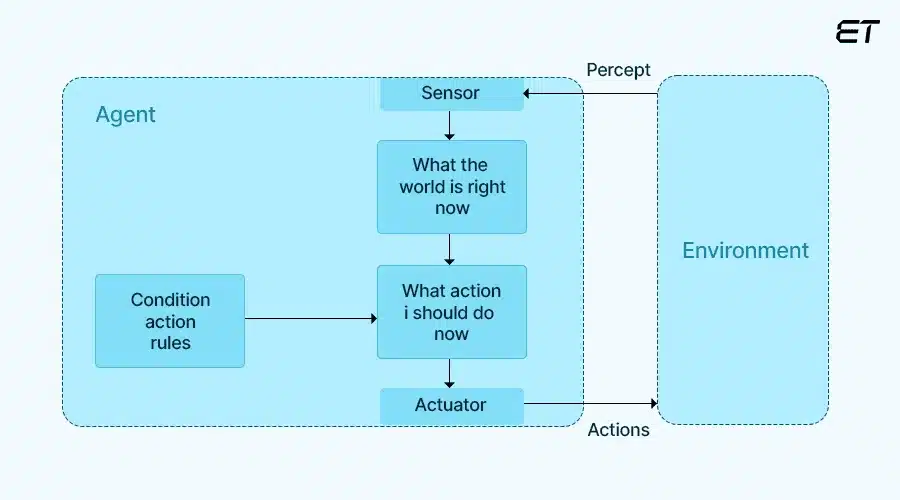
Simple reflex agents are the most basic and easy-to-understand type of AI agents. They are essentially knee-jerk reactors in the AI world.
Here’s how they work:
- They operate in a continuous loop of perception and action. Sensors capture information about the environment
- This information is then matched against a set of pre-programmed rules, which are like a massive “IF…THEN…” list.
- Based on the matched rule, the agent takes a pre-defined action
Simple reflex AI agents have their strengths and weaknesses. Here’s a quick look at the two facets.
Strengths:
- They are simple and easy to implement
- Simple reflex agents are fast and efficient
- These AI agents are suitable for well-defined environments
Weaknesses:
- They have limited adaptability
- They cannot learn from past experiences
- These agents require a fully observable environment
Examples:
| Thermostat | It senses the room temperature and turns the heater on or off based on a pre-set temperature range |
| Light sensor in a street lamp | It detects darkness and triggers the lamp to turn on |
| Vending machine | You select a product, and the machine dispenses it based on your button press |
Overall, simple reflex AI agents, provide a basic framework for building more complex agents and serve well in specific controlled environments.
Model-based Reflex Agents
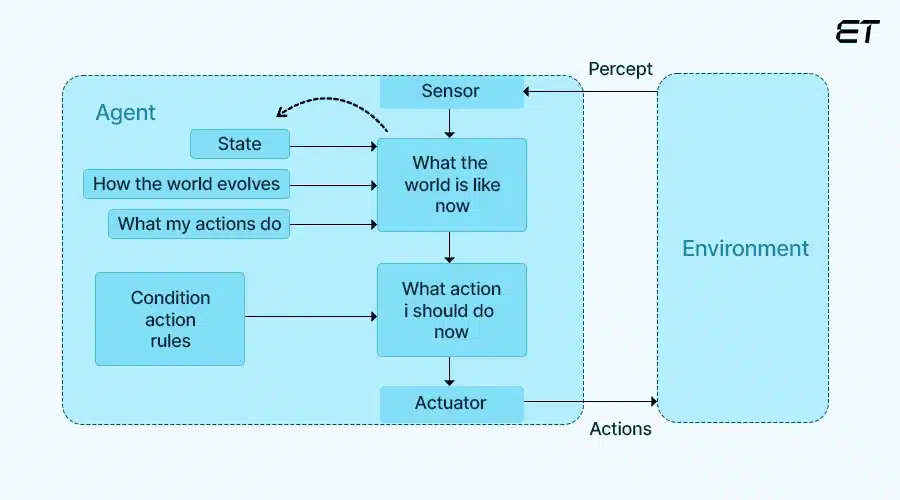
Model-based reflex agents extend the concept of simple reflex agents by incorporating an internal model of the environment.
Here’re the main pointers to consider:
- The internal model allows these agents to handle situations where not everything is directly observable by the sensors
- For instance, simple reflex agents struggle in partially observable environments, where they can’t see everything
- On the other hand, model-based reflex agents address this limitation by building an internal representation of the environment. The model keeps track of the world’s state based on past sensor readings
- When the agent encounters a new situation it can consult its internal model to understand the context
- This agent can then use its pre-programmed rules along with the model to decide on the best course of action
Now, let’s quickly take a look at the benefits and limitations of model-based reflex AI agents.
Benefits:
- They can handle partially observable environments
- Model-based agents are more flexible
- They can use the internal model to make predictions about how the environment might react to their actions
Drawbacks:
- There is an increased level of complexity:
- The agent’s performance relies heavily on the accuracy of its internal model
- There is always an issue of limited learning
Examples:
| Self-driving cars | These automobiles rely on internal models of the road network, traffic lights, lanes, and potential obstacles to navigate safely |
| Robot vacuum cleaners | More advanced models use an internal map of the room to clean efficiently |
| Chatbots (with context awareness) | A chatbot can maintain an internal model of the conversation to provide more relevant responses |
Notably, model-based reflex agents offer a significant improvement over simple reflex agents. However, these AI agents rely on pre-programmed rules and don’t exhibit true learning capabilities.

Speaking of chatbots, Gemini and ChatGPT are two popular picks. But which conversational AI is right for your business? Gemini vs ChatGPT – read the comparison.
Goal-based Agents

You can guess the main principle of this agent from its name, right?
Goal-based AI agents have a specific objective in mind. They actively plan their actions to achieve it.
Here’s a look at how they work:
- To reach their goals, these AI agents employ planning algorithms
- The planning process often involves examining a tree of possibilities, with each branch representing a different action the agent can take.
- Goal-based AI agents consider the potential consequences of each action and choose the one that leads it closer to their goal
- They rely on knowledge representation to perform adequate planning. This knowledge base stores information about the environment, the AI agent’s capabilities, and the relationships between actions and outcomes
Here’re the advantages and weaknesses of this type.
Advantages:
- They can adapt their behavior depending on the current situation
- These AI agents function in environments with multiple possible outcomes
- They have solid reasoning capability
Weaknesses:
- The planning algorithms can be computationally expensive
- Defining clear goals is crucial for the agent’s success
- If the agent doesn’t have complete information about the environment, its planning might be flawed
Examples:
| Robot path planning | A robot might use a goal-based approach to plan its path around obstacles to reach a specific location |
| Game-playing AI | Chess programs or AI opponents in strategy games employ goal-based decision-making to achieve victory |
| Navigation apps | These apps use goal-based algorithms to find the best route for you to reach your destination |
As you can see, goal-based agents are well-suited for tasks that require strategic thinking and the achievement of specific objectives in complex environments.
Utility-based Agents
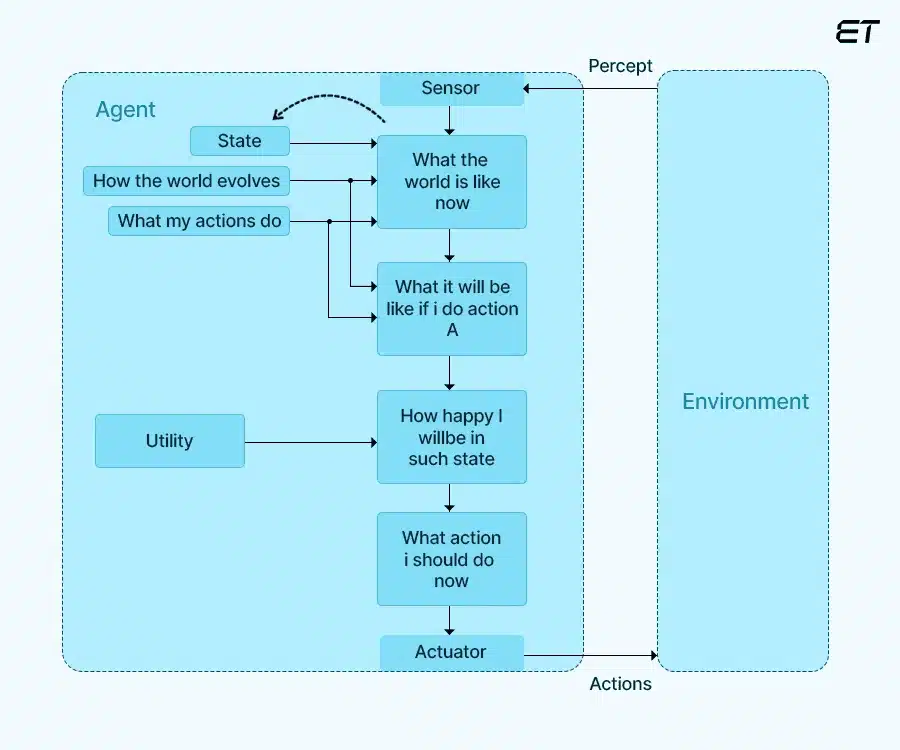
These agents are the next stage of their goal-based counterparts. They also analyze the risks in specific outcomes and assess the entire scenario more deeply.
The AI agent workflow of this type will make the concept clearer:
- Utility-based agents evaluate different courses of action based on a utility function. This function assigns a specific numerical value to each possible outcome, representing how desirable that outcome is for the agent
- The agent strives to maximize its overall score by choosing actions that lead to outcomes with higher utility values
- They gather information about the environment through sensors
- Next, they consider different possible actions to take. For each action, the agent predicts the potential outcomes that can occur
- The utility function assigns a score to each predicted outcome based on how desirable it is for the agent. Then, the agent selects the predicted action to lead to the outcome with the highest utility value
Utility-based AI agents have some specific set of advantages and limitations. So, you should understand them before choosing these programs as your auxiliary units.
Benefits:
- These AI agents are flexible and adaptive
- They can incorporate the agent’s preferences and priorities into their decision-making process
- Utility-based agents can consider factors like risk, time, and effort when evaluating different options
Limitations:
- Designing the utility function is complex
- Evaluating the utility of all possible outcomes can be computationally expensive
- There is a degree of uncertainty about the outcomes
Examples:
| Recommendation systems | These systems recommend products, movies, or music to users based on a predicted utility score of how much the user would enjoy them |
| Self-driving cars | A utility-based self-driving car can consider factors like safety, efficiency, and passenger comfort when making decisions |
| Trading robots | These robots use utility functions to evaluate investment options and trading decisions based on maximizing their ROI |
So, by incorporating the concept of utility, these agents exhibit more nuanced decision-making capabilities.

Trading robots can be good tools for the finance sector. Similarly, AI in insurance is a hot topic that you can unravel.
Learning Agents
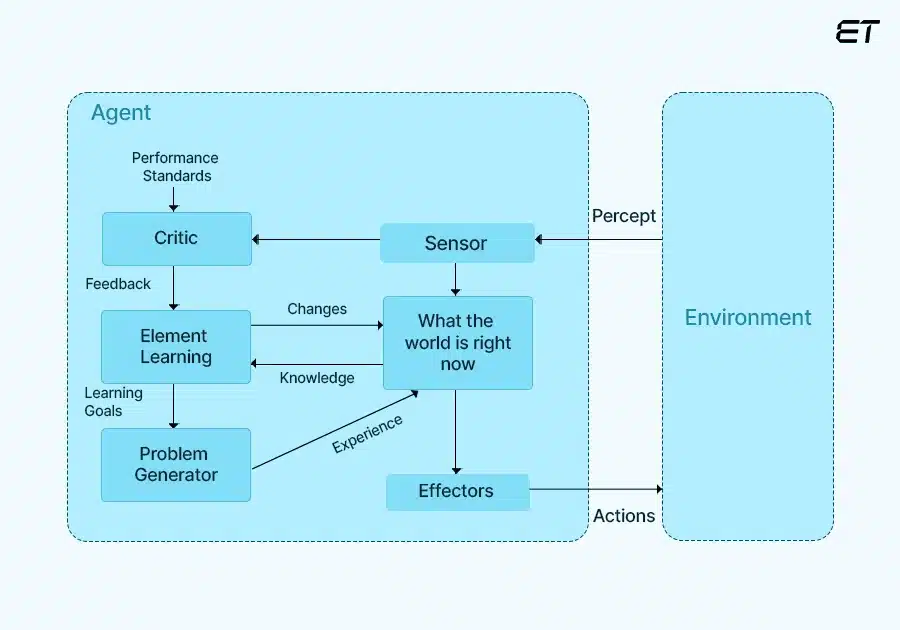
The last major AI agent category is that of learning agents. You can consider them to be the top-most types in this domain.
Here’s how learning agents work:
- Learning agents have the potential to learn from their interactions with the environment. This trait allows them to adapt their behavior over time
- These agents have specific components, making them effective. These components are the learning element, critic, performance element, and knowledge representation
- Now, the working of learning agents is a collective result of each component’s utility
- The learning element is responsible for processing new information and updating the agent’s knowledge or decision-making strategy
- Next, the critic evaluates the agent’s performance and provides feedback on how well it’s doing compared to its goals
- The performance element selects actions for the agent to take in the environment based on its current knowledge and the critic’s feedback
- Finally, knowledge representation refers to how the agent stores and organizes information about the environment and itself
The advantages and drawbacks of this AI agent are sufficient to summarize its entire utility.
Benefits:
- Learning agents can adjust to new situations and environments by continuously improving their performance
- They can handle complex tasks
- These AI agents have real-world applicability
Drawbacks:
- Learning agents require a significant amount of data and time
- The agent needs to balance exploring new options for learning with exploiting its current knowledge for good performance
- Understanding how a learning agent arrived at a particular decision can be challenging
Examples:
| Personal assistants | Virtual assistants like Siri or Alexa learn your preferences and voice patterns to provide more personalized responses |
| Spam filters | These email filters use machine learning to identify spam emails from past examples |
| Self-driving cars | These automobiles rely on machine learning to continuously improve their ability to navigate roads and respond to changing situations |
Overall, learning agents are precious for various tasks and will pave the way for even more intelligent and autonomous systems in the future.
Functions of an AI Agent

By now, you must’ve realized the wide variety of functions and usage scope of AI agents. But, it’s natural to wonder about their functions.
So, here’s a general overview for your perusal.
Function #1: Perceive the Environment
AI agents gather information about their surroundings through sensors. These sensors can include cameras, microphones, web search functions (for software agents), or any other sensor modality relevant to their task.
Function #2: Process Information
The agent interprets raw sensory data and visually represents the environment. This stage involves techniques like image recognition, natural language processing, or simply analyzing sensor readings.
Function #3: Reason and Make Decisions
Based on their comprehension of the environment and programmed goals, the agent uses reasoning algorithms to decide on the best course of action. This step includes planning a sequence of actions, evaluating different options, or simply reacting to a stimulus based on pre-defined rules.
Function #4: Take Actions
AI agents use actuators to affect the environment. These tools could involve robots moving their limbs, software programs generating text or recommendations, or any other action that achieves the agent’s goals.
Function #5: Learn and Improve
Some AI agents (like the learning type) can study from their experiences and adapt their behavior over time. This learning process can involve techniques like supervised learning, unsupervised learning, or reinforcement learning.
All in all, these core functions allow agents to interact meaningfully with the world.
AI Agent Workflow
What is the meaning of workflow in the case of AI agents?
Well, workflows refer to the structured processes that define how agents perform their tasks. These workflows map out an agent’s steps to achieve its goals and integrate seamlessly with its capabilities.
Here’s a breakdown of the key aspects of AI agent workflows:
- Data Integration: The workflow typically starts with data integration from various sources. This data could be sensor readings, user inputs, historical data, or anything relevant to the agent’s task
- Pre-processing and Transformation: The raw data might need pre-processing and transformation to make it suitable for the agent to understand and utilize. This might involve cleaning, filtering, or formatting the data
- Decision Points: AI agent workflows often include decision points where the agent leverages its capabilities
- Action Execution: Based on the decisions, the agent workflow dictates how the agent takes action
This action can involve:
- Sending control signals to robots or actuators
- Generating text or recommendations for users
- Updating internal models or knowledge bases
Defining workflows is beneficial on many fronts. Here are some main pointers that you can consider:
- Efficiency and Automation
- Improved Agent Performance
- Enhanced Scalability
Overall, workflows play a crucial role in ensuring that agents function effectively and achieve their goals in a structured and optimized manner.

AI is all about modernization. One of the AI types, generative AI is already modernizing legacy systems. Know how GenAI achieves legacy modernization this feat.
Prominent AI Agents and Their Utility
You must be thinking, ‘well, the concept seems interesting. But can I know some real-life examples for more simplification?’
If that’s the case, refer the following table and understand the utility of some of the most well-known AI agents.
| AI Agent Type | Example | Utility |
| Smart Assistant | Siri, Alexa, and Google Assistant | Provide voice-controlled assistance, set reminders, control smart home devices, and retrieve information |
| Recommendation System | Netflix recommendations, Amazon product recommendations | Recommend products, movies, music, or other content based on user preferences and past behavior |
| Chatbot | Customer service chatbots, FAQ chatbots | Automate customer service interactions, answer frequently asked questions and provide basic support |
| Self-driving Car | Waymo, Tesla Autopilot | Navigate roads safely and efficiently, transporting passengers and goods autonomously |
| Spam Filter | The Gmail spam filter | Identifies and filters spam emails, protecting users from unwanted messages |
| Machine Translation | Google Translate, DeepL | Translate text from one language to another, facilitating communication across languages |
| Robot Vacuum Cleaner | Roomba | Clean floors autonomously, reducing manual effort in maintaining cleanliness |
What are the Benefits of Using AI Agents?
AI agents offer a wide range of benefits across various domains like the following:
Increased Efficiency and Productivity
AI agents can automate repetitive tasks, freeing up human workers for more complex and creative endeavors. This leads to significant time savings and increased productivity.
Unlike human workers, AI agents can operate around the clock, providing continuous service and support. AI agents can handle multiple tasks simultaneously, ensuring that no opportunity is missed and maximizing resource utilization.
Enhanced Decision-Making
AI agents can analyze vast amounts of data quickly and accurately, providing valuable insights that inform better decision-making processes. By identifying patterns and trends, AI agents can predict future outcomes, enabling proactive measures and risk mitigation.
In addition, AI agents can tailor recommendations and services to individual needs and preferences, leading to more effective and satisfying experiences.
Improved Customer Experience
AI agents can provide personalized and timely interactions with customers, enhancing their experience and building stronger relationships. Customers can receive immediate assistance and support at any time, improving their overall satisfaction.
Cost Savings
By automating tasks and providing 24/7 support, AI agents can significantly reduce labor costs. AI agents can optimize resource allocation, ensuring that resources are used efficiently and effectively.
Also, AI agents can minimize human error, reducing the costs associated with mistakes and rework. Overall, AI agents offer a powerful tool for enhancing efficiency, improving decision-making, enhancing customer experience, reducing costs, and driving innovation.
Practical Challenges of Using AI Agents

AI agents hold immense potential. However, there are practical challenges to consider when using them. In this section, you can read some of the most practical ones to consider.
Data Dependence
AI agents rely heavily on data for training and operation. Poor quality data can lead to specific inaccurate results.
In addition, training complex agents requires vast amounts of data. This volume can be a hurdle for tasks where acquiring sufficient data is expensive or difficult. Finally, using personal data for AI development raises privacy concerns
Explainability and Trust
Some AI models can be opaque in their decision-making process. So, understanding how an AI agent arrives at a decision can be difficult.
Furthermore, these agents can inherit biases from the pre-trained data. This bias can lead to discriminatory or unfair outcomes. For instance, a loan approval AI can bias against a certain demographic.
Technical Challenges
Training and running complex AI models can require significant computational resources, making them expensive to deploy and maintain.
Also, AI agents can be vulnerable to hacking or manipulation. So, securing these systems is essential to prevent misuse. While some agents can learn and adapt, their reasoning capabilities are still under development.
Societal Consideration
Automation through AI agents can lead to job losses in certain sectors. Further, the development and use of AI raise ethical questions, such as bias, fairness, and potential job displacement.
As AI capabilities advance, robust regulations and control mechanisms are necessary to ensure responsible development and use.
These challenges highlight the importance of responsible AI development and deployment. So, by addressing these issues, we can leverage the power of AI agents while mitigating potential risks.
To Wrap Up
AI agents are smart computer programs that can perceive, reason about, and act on their environment. They have the potential to be valuable tools across industries.
From chatbots streamlining customer service to self-driving cars navigating roads, these agents can transform our world. However, challenges like data dependence, explainability, and societal considerations require careful attention.
By acknowledging these limitations and fostering responsible development, AI agents have the potential to become powerful partners for progress. So, if you want to develop your own customized AI agent, connect with us.
Even if the technology behind these programs looks complex, our services have great potential to handle all the intricate requirements.
Frequently Asked Questions
1. Is ChatGPT an AI agent?
You can consider ChatGPT to be a specialized AI agent operating within text generation. It demonstrates impressive capabilities in processing and responding to textual information. However, it has limitations compared to more versatile agents.
2. What’s the difference between GPT agent and Autogpt?
It is essential to think of GPT Agent as a toolbox where you can build various applications using GPT technology. You control what the tool does. On the contrary, AutoGPT is like a self-directed robot using GPT-4 to navigate the world, set its own goals, and take actions based on its understanding.
3. Should I use an AI agent?
You can use AI agents if you have repetitive tasks, require data analysis, desire personalization, and need 24×7 availability. On the other hand, if data privacy is a significant concern and a task requires human judgment, using an agent can’t be the best choice.





